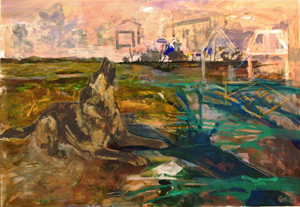Animals often stand in for people in the
provocativee landscapes of Grace Munakata's paintings
By Victoria Dalkey, The Sacramento Bee art correspondent
 |
"Dispatch"/acrylic and mixed media on gatorboard,
41" x 65", 2009,Grace Munakata.
|
| |
|
Ideas of home and homelessness play a central role in many of Grace Munakata's new acrylic and mixed-media paintings at b. sakata garo.
"What is home? How do we define it? Where is it?" she asks, looking at images of dogs and foxes in landscapes made up of nature encroached upon by man.
Ghosts of pure nature hover in a stand of Italianate trees, but it is the landscape of the dump, of the tent city, of the homeless encampment that takes precedence.
The dogs and other animals come and go, never as much at home in the landscape as they once were, as we once were.
"We don't belong in the landscape anymore," Munakata observes at the gallery. "Now we have to go to places where we can experience the landscape in its pure form."
Recently returned from a sojourn at Sea Ranch, she includes three charcoal drawings of the coast in her show. They are powerful and painterly drawings of a nature that is haunted by solitude and beauty.
They contrast with the fragmented quality of Munakata's acrylics, which range from the collage-like "Petits Soins" ("Small Cares"), with its patterns and scraps of images arranged in a playful potpourri of animal and organic forms, to the disturbed window space of "Dispatch," with its dog yearning for home while fragments of houses drawn by children float over the horizon.
Munakata uses animals as surrogates for human conduct but occasionally includes a human figure, as in "Poppy Field," with its references to the Wizard of Oz, Dorothy, Toto and the Scarecrow. It's a light and lyrical image that melds the realms of imagination and reality.
"Bestiary" is a busy composition in which animals – rabbits, toads, foxes, kittens and birds – roil in a swirl of activity, creating a world of animal behavior – leaping, play-fighting, feeding and flying – that is as rich as a medieval tapestry.
Playful as it is, it has, like many of Munakata's new paintings, a dark edge. The new world she posits in these works is not bleak but shadowed with loss and longing. Dogs and other animals seem to be caught in an endless state of becoming, departing, returning, pausing in their travails.
In "Gleaners," castoff clothing and the detritus of a garbage dump call up associations with Third World shantytowns where people scavenge for subsistence. Yet there is beauty in the damaged world.
In "Return Road," a ghostly dog slinks away at dusk under a pink orb that might be a moon or a paper lantern. On the right, a mosaic of colors and shapes suggests a gate and tile floor with leaves strewn about, a romantic scene from which the dog seems expelled.
"Vico's Coat" is based on a story by John Berger about a dog who lives with the homeless and uses a coat as a map for where his human family lives. Caught between a junk heap of castoff chairs and mattresses on the left and the lumpy coat that becomes a landscape of rocks, the dog is a go-between for the humans who are represented by the detritus they shed in a world that's falling apart.
Munakata's Japanese heritage is a submerged theme that plays a strong role in her work. In a recent statement, she wrote: "Growing up in a Japanese American home, things consorted with other things without distinct categories. My grandfather's gestural senryuu poetry shared space with Western watercolors of flowers and landscapes. Elaborate dolls in kimonos mingled with porcelain flowers and plastic horses. My mother was a seamstress whose buttons, pins and piles of striped and floral fabric filled her utility room."
In this mélange of images, things became other things as they do in Munakata's paintings, where patterns and fragments of images mix with abstract markings and, in these newest works, recognizable subject matter.
In "Sojourn," the most recent painting in the show, she returns to a purer abstraction, though the work is centered around an image of a stand of trees at dusk. Surrounding the image is a swirl of atmospheric effects and pure color that interrupts the narrative. It's a buoyant and beautiful image that still holds hope for the healing qualities of nature.
Grace Munakata
WHERE: b. sakata garo, 923 20th St.
WHEN: Noon to 6 p.m. Tuesdays-Saturdays, through May 2
INFORMATION: (916) 447-4276
